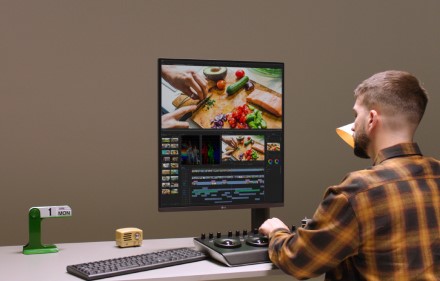Regardless of whether we are working in the office or at home, we spend more than six hours a day looking at a monitor. LG Electronics explains which monitor to choose for work and play.

Bigger is better
It’s the same with monitors as with TVs – the bigger the better. For example, the latest generation of ultrawide monitors are multifunctional and great assistants for large-scale work. They have an extra-wide screen, which makes them great for working on photos, videos, and other projects, as well as playing video games.
Large monitors can be especially useful for people working in creative fields like designers, photographers, and game developers, but it can also be very useful for other professionals who work with large amounts of information on a daily basis. Curved monitors have become particularly popular in recent years. On this monitor, it will be a pleasure to look at any image, even if it is only Excel tables, and there will be a special feeling when watching movies or playing video games.
A monitor for work and video games?
For those who want to use the monitor for work purposes, but at the same time to keep up with the latest innovations in the best video games, choosing a high quality monitor is very important. Of particular note is its ability to reduce frame lag and provide quick response in the heat of battle. Every gamer knows that speed is essential for high-performance video game monitors. Experts recommend choosing a monitor with a better 1 ms response time, which ensures that the image does not blur when changing operations. Statistics improve as response times decrease, regardless of the video game. Image quality and speed go hand in hand, so if the monitor is slow, it will limit the performance of any powerful graphics card.
Ergonomics are not that important
We often talk about an ergonomic work environment – a chair or a height-adjustable desk suitable for long working hours – but we forget to pay attention to how ergonomic your monitor is. Although the area of the work area is fixed, it is recommended to choose a monitor with a stand that allows you to change the height, suitable for the height of the user and the sitting position.
How to avoid eye strain?
Looking too closely at a monitor can cause eye fatigue, and prolonged viewing can cause more strain on the eyes, especially if you are in a dark room or during dark hours of the day. For example, when looking at a monitor in a dark room, the pupils dilate to receive more light. This is where the latest UltraFine™ monitors come in handy. They can automatically adjust the screen brightness according to the light intensity of the room, thereby reducing eye strain.
Conversely, when your eyes get tired while looking at the monitor, you should look away from the screen for a while and focus on a distant object. You can also apply the 20-20-20 rule – look at another object 20 meters away for 20 seconds every 20 minutes.

Problem solver. Incurable bacon specialist. Falls down a lot. Coffee maven. Communicator.



